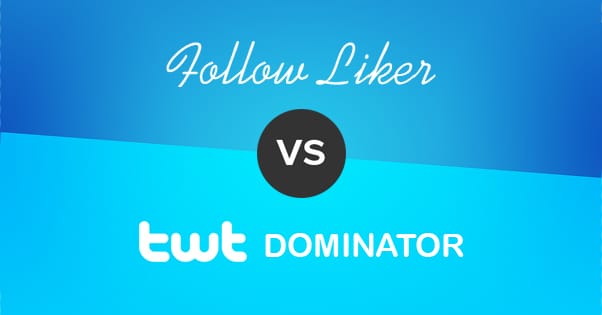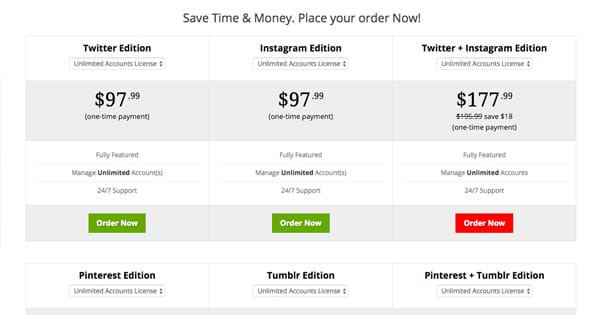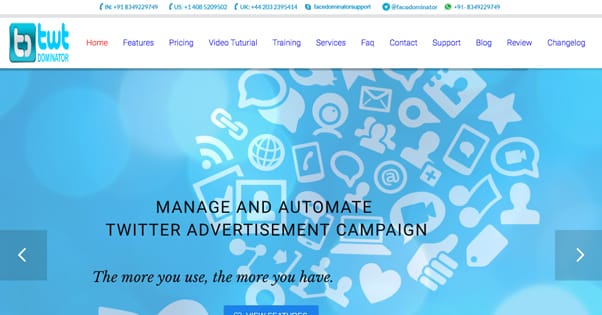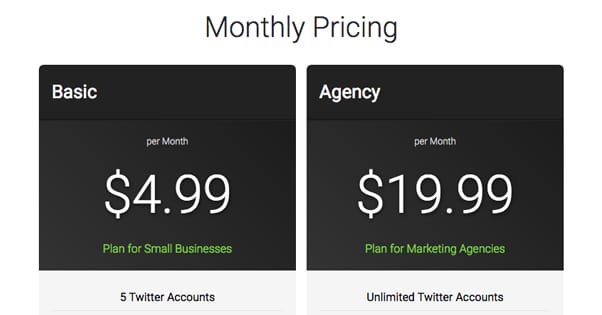On this site, I like to keep things generally white hat. It’s easier and safer to grow a brand or a business using legitimate tools and techniques than it is to delve into black hat strategies.
Think about it like this. Black hat strategies work – they have to, or they wouldn’t keep circulating – but the popularity they give you is either unsustainable, valueless, or dangerous. Unsustainable growth is a spike and then a flatline, followed by a decline as the black hat actions are reversed, the fake accounts banned, or what have you. Valueless growth is growing via bot followers that do nothing for you but inflate a number; they don’t promote you, they don’t buy your stuff, and they don’t engage with your posts. Dangerous growth is using techniques that can get you banned from Twitter, or from whatever other site you’re using.
White hat strategies, by contrast, tend to be much slower but much safer. Rather than mountains in your analytics, with steep peaks and sharp drops into deep valleys, you have a long, slow incline of growth. That growth can compound over time and get faster and faster, though it certainly might not, depending on how you implement your marketing. However, it’s also secure. It takes a very significant mistake or the complete abandonment of your account to get rid of that accumulated value.
I also recognize that there are a lot of tools out there that can be used for both white and black hat purposes. If you use them carefully and stay within the boundaries of what’s acceptable, you can get a lot of mileage out of them. On the other hand, if you set and forget them and assume they’ll make you grow, you could get slapped just as hard.
With that in mind, let’s take a look at two different tools I’ve seen circulating. Are they safe? Are they decent? Do they work?
FollowLiker
FollowLiker can be found here. They bill themselves as a “powerful, reliable, and super flexible multipurpose software.” It’s meant for automating your social media tasks. Now, I’ve written about Twitter automation before, and even compiled a list of great tools you can use. You’ll note that this isn’t on there, but should it be?
FollowLiker has variations for Twitter, Tumblr, Instagram, and Pinterest. I’m going to focus on the Twitter tool primarily, though you can assume that the others are more or less the same. They all offer the same basic functionality, at any rate. What functionality is that?
- Automatically follow users based on various criteria. Follow users who follow you, follow all of the followers of a user, follow users who use a given hashtag or keyword, follow users using a given language or in a given location, follow a custom list of users, and limit it all based on the follower/following ratio.
- Automatically unfollow users who don’t follow you back after X amount of time. This is one of Twitter’s big red flags – look up follower churn – so they allow you to limit how many unfollows you run per day. They also allow whitelists to keep specific followers.
- Automatic posting of tweets throughout the day. There’s nothing inherently black or white hat about scheduling, at least, so this function is perfectly fine.
- Automatic retweets based on tweets of a user, tweets from specific locations, and other criteria, similar to he follow criteria above.
- Automatic replies. This can get tricky, and it looks like FollowLiker is allowing broad-spectrum replies to tweets based on locations, keywords, and other criteria, with a potential delay to make it appear more organic. Used properly this feature can be powerful for customer service and engagement, but I somehow doubt they’re encouraging proper use.
- Automatic tweet favorites and unfavorites. Again, this is all based on criteria such as location and language. The automatic unfavorite feature is a bit shady as well, set to favorite a tweet to encourage a follow or like in return, and unfavorite the message later. Also, Twitter turned favorites into likes some time ago, and FollowLiker hasn’t bothered to update their website. Not a good sign.
- Automatic direct messaging. Again, much like automated replies, this can be a great feature for customer service purposes, but when used to send a message to anyone for no reason it can very quickly devolve into something that looks like spam.
- User search, which enables you to find users based on keywords, who they follow or who is following them, their location, their interests, their participation in trends, and more. It also has filters to remove egg profiles, to avoid filling your list with low-effort fakes. This can actually be quite useful and I wouldn’t call it a spam feature unless it’s used with auto-messaging.
- Tweet search, which has all of the same sorts of searches and filters as Twitter’s default search, just using the FollowLiker interface to do it.
- Automatic crawl tweets, which convert RSS feeds or website updates into new tweets. A nice feature to have built-in, so you don’t need to go and use IFTTT or Zapier separately.
- Blacklist features for all of the above, to flag certain users as people who should never be followed, retweeted, liked, or shared in any way. It’s also possible to auto-blacklist users who unfollow you, which seems unnecessary to me.
- Proxy integration. In the course of white hat Twitter usage, you generally don’t need to use a web proxy. They’re typically only used to get around rate limits or to avoid IP issues with running multiple accounts at a time, and even then, only when you’re running into black hat filtering systems.
- Multiple account support. There’s nothing wrong with using multiple accounts — many franchises and businesses run numerous accounts, or at least just one for the brand and one for customer service – but setting a tool like this to run one more or less automatically is leaning pretty heavily towards spam purposes.
That’s largely an array of features that are either white hat or can be used in a white hat manner, but it all comes down to how it’s presented. If you look at a screenshot of their program on their site, it’s pretty clearly aimed at people managing multiple accounts at a time, as automatically as possible. Twitter loses a lot of value when you aren’t giving it a personal touch, so I would classify the program as a sort of dark gray. It’s not purely a spam tool, but it’s not a dashboard or CMS by any stretch of the imagination. It’s meant for bulk usage, and even their pricing reflects that. All versions include all features. The lowest is a one time payment of $58 and is limited to one account. For five accounts it costs $78, and for unlimited accounts it costs $98.
One thing to note is that while they claim around-the-clock support, I imagine that only applies to account issues and bugs with the program itself. Given that they haven’t even updated their site away from the favorites terminology, I wouldn’t expect the program to receive feature updates beyond fixing it if Twitter changes an API.
Interestingly, they have a reviews page on their site, which as you might expect is full of love for the program. However, they don’t hide the fact that it’s just a bot. All of their reviews are screenshots of forum posts, most if not all pulled from Black Hat World.
My verdict: Possibly okay but not great. FollowLiker is a bot program meant to grow an account while you don’t have to pay attention to it at all. It builds accounts that can then be sold or used for selling fake followers, and it’s really not great for legitimate businesses. All of the good, useful features can be found in much more robust dashboards, which generally have better options as well. I’d give this one a pass.
TwtDominator
Next up on the list is TwtDominator, subsequently referred to as TD. They bill themselves as the “all in one Twitter marketing tool for marketers.” My first gripe with the tool is not actually with the tool itself, but rather with the website. The copy written for the site is poor overall. Just look at the FAQ with the question “is scraping website is legal?” It’s clearly a website put together with a minimum level of quality just to get it going, and they’ve done it in bulk. The Dominator like of products includes one for Twitter, one for LinekdIn, one for Reddit, one for Craigslist, oen for GumTree, one for Google Plus, one for Kijiji, one for Backpage, and a bunch more. They all have fancy logos but they’re all the same, and for that matter, their official support line is a Skype account called FaceDominatorSupport. Clearly they started with a Facebook program and expanded from there.
The FAQ has a few more signs as to what the quality and purpose of the product will be. There are only a few questions, and they aren’t about setup, linking accounts, or configurations. Instead, they’re about using proxies and account lists. Once again, like FL above, TD is a bulk account manager.
What features does TD bring to the table, then? They have the ability to upload numerous accounts to their management list, but they don’t seem to have much in the way of segmentation between them. This means all of your accounts will take the same actions in the same way, through proxies you can assign to each of them. The actions your accounts can take include following account lists, tweeting or replying to tweets with trend keywords, unfollowing anyone who doesn’t follow you back, managing an account directly, creating action campaigns, and retweeting/favoriting content.
There’s also mention of a “friend adder” that talks about friends and fan pages, which seems likely to be a holdover from Facebook management and has nothing to do with Twitter. Plus there’s the mention of favorites rather than likes, again, showing they haven’t changed terminology along with Twitter’s changes.
Unlike FL, there’s no veneer of using the tool carefully in order to eke out some white hat value as a brand. This tool is specifically geared towards creating and growing a large roster of thin accounts for whatever future use you might have for them. I’m sure Fiverr sellers and other shady black hats are all over this kind of thing. Then again, maybe they aren’t; it’s not cheap.
FL was a bit under $100 to buy the software for unlimited use. If you want the equivalent no-limits lifetime purchase of TD, you’d be paying $500. They have a limited version for just 5 accounts for $250. Or if you want to spend less per month and pay monthly or yearly, you can pay either $5 or $20 per month, or $50 or $200 per year, for the 5-account or unlimited account varieties. In all cases, the pricing is pretty steep, and the only one I’d even be tempted by is the $5 per month version just to experiment with the software. Even then, it’s not something I would recommend.
I suppose if you want to build up a hundred or more accounts, with the absolute minimum amount of effort spend on doing so, this would be the way to do it. The trouble is, what’s the purpose of doing so? You’re either selling the accounts or you’re using them for fake follows and engagement, all of which is against the Twitter terms of service. You’ll have some attrition as Twitter identifies and bans some of your accounts, and if you’re too brazen with your actions, they could all be wiped out. It’s not profitable compared to just building accounts organically.
My verdict: don’t bother. If you’re a spammer you can get your spam recommendations from Black Hat World or Digital Point or whatever other forums you frequent. If you’re trying to build a business or a brand name for yourself, this tool isn’t for you.








